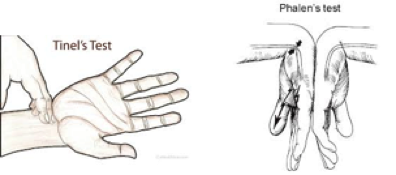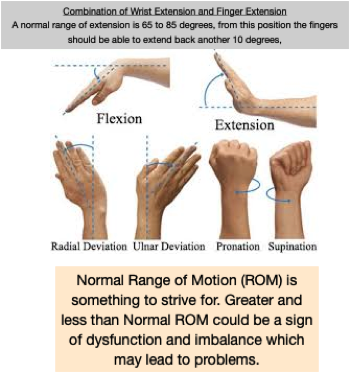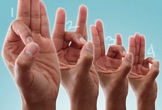Pain and numbness in the fingers, hands, and wrists could be caused from overuse from work, sport, and life as well as poor posture of the wrist and neck. See your doctor if you have weakness or pain or numbness. This program is for care and prevention, not treatment. Never do if cause more pain or numbness.
All these exercises takes minutes a day and can be done almost anywhere. So there are no excuses not to do. Good posture of the wrist (not bent), forarm (at or below 90 degrees), and neck (not forward) are also very important. Studies have found that wrist splintting/bracing is very beneficial for those who have Carpal Tunnel Syndrome (CTS) and wrist pain especially at night.
It is also a good idea to perform some of the basic exercises from our neck care program because pain and numbness in the hand and arm are sometimes referred from the neck.
MORE DETAILS ON CTS from WebMed: CTS is a common condition that causes pain, numbness, and tingling in the hand (thumb, index, and middle finger). The condition occurs when one of the major nerves to the hand — the median nerve — is squeezed or compressed as it travels through the wrist. Common wrist factors causing it - Repetitive hand use. Repeating the same hand and wrist motions or activities over a prolonged period of time may aggravate the tendons in the wrist, causing swelling that puts pressure on the nerve. - Hand and wrist position. Doing activities that involve extreme flexion or extension of the hand and wrist for a prolonged period of time can increase pressure on the nerve. Example: bent wrist all night. That is why a wrist support or splint may help. Therefore avoid repetitive hand use and awkward hand positions. Excerpt from and for more info go to : www.webmd.com)
SELF TREATMENTS
Here are 8 home remedies for carpal tunnel relief which are also good for wrist care FROM HEALTHLINE that I recommend:
1 Take breaks from repetitive tasks. HIGHLY AGREE
2 Wear splints on your wrists. HIGHLY AGREE ESP. AT NIGHT
3 Lighten up. TRY TO FOCUS ON LIGHTENING YOUR GRIP. Some people use too tight of a grip al the time.
4 Mind your flexion. Avoid activities that make your wrists flex to the extreme in either direction. Try keeping your wrists neutral as much as possible (STRAIGHT). HIGHLY AGREE
5 Stay warm. Try shaking your hands out as well every couple of hours.
6 Stretch it out. One of my favorites is to make a light fist and then widen your fingers until they are straight again. Repeat this action five to 15 times.
7 Elevate your hands and wrists whenever possible.
8 Try over-the-counter (OTC) medications. TALK TO YOUR DOCTOR.
Carpal Tunnel Relief: 9 Home Remedies - Healthline
Not mentioned above is desk elbow posture. It matters - Elbows should be kept close to the body, bent at roughly a right angle (no less than 90 degrees, but slightly more is acceptable), and wrists straight. Do not stay in the same posture.
Finger, Hand, and Wrist Care Program
Know Your Joints
SELF TESTS
Normal Range of Motion of the Fingers
You should be able to do the below pictured finger movements with pain free motion. These motions are also exercise (see others in exercise section below). You can do these throughout the day. Both hands should be the same.
Normal Range of Motion of the Wrist
Normal wrist and elbow range of motion is essential for both wrist and elbow health. Do these test on yourself. Both arms should be the same.
Wrist Bending
Forward bending of your wrist is called flexion. This motion is needed for daily activities such as styling your hair, writing, getting dressed, using a screwdriver and lifting heavy objects. Normal wrist flexion is approximately 70 to 90 degrees. Extension -- backward bending of your wrist -- is necessary for opening your car door, pushing a door closed, pressing up on the arms of a chair and driving. Normal wrist extension is approximately 65 to 85 degrees.
Wrist Deviation
Your wrist joint deviates -- or tilts -- from side to side. Ulnar deviation tilts your wrist toward the pinkie side of your hand. Radial deviation tilts your wrist toward the thumb side of your hand. These movements are used frequently during the day as you type, write, get dressed and talk on the phone. Normal ulnar deviation is approximately 25 to 40 degrees, while radial deviation is approximately 15 to 25 degrees.
Elbow Flexion and Extension
Normal elbow flexion is approximately 110 degrees from full extension, while normal extension is approximately 10 degrees from full extension. Compare sides. Both sides should be the same. If not try doing exercises to improve and seek out medical attention.
Answer these questions if you suspect carpal tunnel syndrome: See this questionnaire to help determine if you may have carpal tunnel syndrome. If you have an average score of >1.9 please seek out professional medical advice.
Hand Shaking Test
A good way you can test yourself is by doing hand shaking. Mimic shaking a hand that is not there. If symptoms (tingling, numbness, pain) goes aways it could be a sign that you may have carpal tunnel syndrome.
These tests are commonly used to diagnose carpal tunnel syndrome: From webmed. Although their validity is suspect.
Tinel's sign test
Your doctor taps on the inside of your wrist over the median nerve. If you feel tingling, numbness, "pins and needles," or a mild "electrical shock" sensation in your hand when tapped on the wrist, you may have carpal tunnel syndrome. Try it on yourself. See webmed for test.
Phalen's sign test
You hold your arms out in front of you and then flex your wrists, letting your hands hang down for about 60 seconds. If you feel tingling, numbness, or pain in the fingers within 60 seconds, you may have carpal tunnel syndrome. Try it on yourself.
If you get a postive test from any of the above please seek out your doctor for a diagnosis.

Remember the following


Elbows at or below 90 degrees and wrist neutral

Make an appointment with us either in person or online to talk about a conditioning program that is specific for you and possibly have a wrist range of motion assessment. Email us at fittec@me.com. Every body is different so every conditioning program must be designed to account for that.




Have us test your grip strength and range of motion of your wrist and elbow to determine if you are at risk.
The tests performed within our evaluation are not diagnostic. Please see your doctor to get a diagnosis if the tests performed suggest a possible issue.
Perform these test on yourself to determine your status.